Native Son: July 2014
by Steven Chamblee
Oregon to Texas
Opportunity is missed by most people because it is dressed in overalls and looks like work. — Thomas Edison
I cheerfully told my in-laws that, if they ever felt they wanted to move down here, I would drive their load of belongings from Oregon to Texas. They smiled sweetly and said they’d be ready to go in three weeks.
Moving after 41 years in the same house requires the services of Superman, Atlas, and George Patton. Unfortunately, none of them showed up. So a small group of mere mortals set about dividing the wheat of the future from the chaff of the past. As I ceremoniously closed the truck cargo door, I tossed a few naproxen sodium down my throat and chucked the agony of moving into the chaff pile.
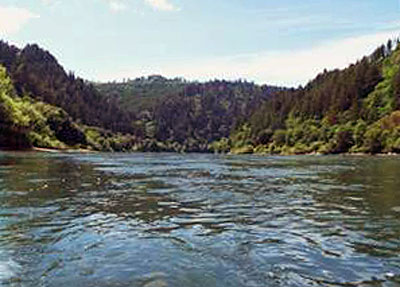
The slow, churning energy of the Umpqua River. Photos courtesy of Steven Chamblee.
The in-laws headed for the airport and I headed for the open road. It got beautiful in a heartbeat as I turned off of I-5 and headed down the Umpqua River Valley toward the coast. Framed by tall trees, the Umpqua does a relaxed roll through pleasant valleys on its way to the Pacific, and I had to make a quick stop to touch her. There is a deep, churning sound to big rivers, even when there’s nary a wave or whitecap in sight. Maybe it’s the sound of energy, and maybe I’m the only one who can hear it, but it’s there. The water is cold, and I assume her headwaters are far away in the Cascade Mountains. It seems strange to me to know this river is flowing straight west, and I ponder the thought that she is just one result of all the precipitation that folks around here so take for granted that they groan when it rains. C’est la vie….
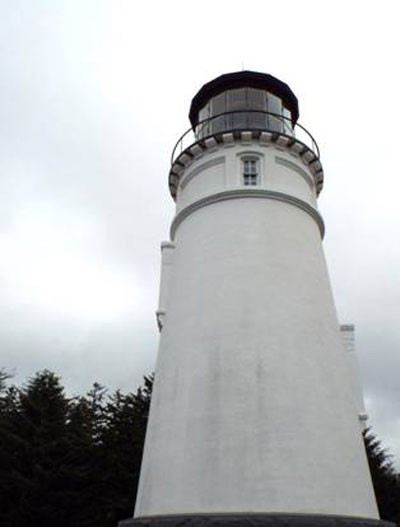
The Umpqua River Lighthouse rises 65 feet to shine light out to sea.
I first see the ocean at Winchester Bay, and marvel at that little triangular jetty that protects the mouth of the Umpqua from erosion. I laugh at the idea that when you are on shore, all you can look at is the ocean, and when you are on the ocean, all you can look at is the shore. An old lighthouse stands nearby, with a sign that says the lens weighs two tons and its 616 prisms were made in Paris in 1890. I wonder if any of those Parisians had ever seen the ocean, or even thought about the epic Man vs. Nature battles that took place during storms back then, and how a lighthouse beam was often the only sign of hope for many desperate souls clinging to little wooden ships. I suppose these battles continue today. Even so, I reckon the ocean must be kind; she could easily devour us all if she weren’t.
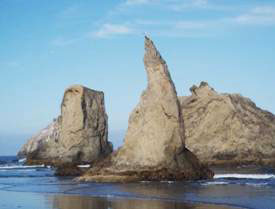
A knife-bladed rock rises more than 50 feet into the air at Bandon, Oregon.
I realize a lifelong dream at Bandon, where ocean-sculpted rocks erupt from the coastline and continue on into the sea, creating one of the most beautiful landscapes I’ve ever seen. Every inch of it is ridiculously dramatic, ridiculously inspiring. Tears roll down my face from the sheer magnificence of it all. The breeze blows constantly. The waves pound endlessly. Today may be just another day for the wind and the water, but today is the day that I am here to witness the sculpture that they have worked upon for eons. Others may well enjoy the incredible panorama, but I know this was created just for me.
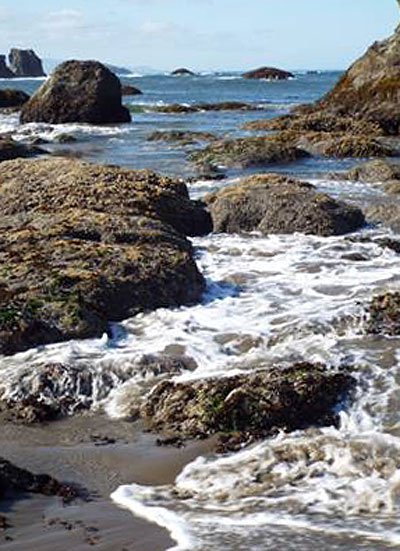
The intricate, rocky coastline at Bandon.
I take hundreds of photos. One side of me knows it’s pointless to try to capture my emotional milieu; the other hopes to somehow use the camera as a third eye — to capture this dreamscape to share with the future me, the one who may not remember it so well.
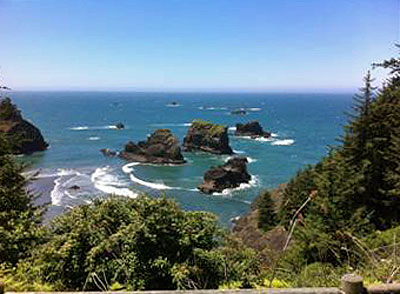
The mind- and mood-altering coastline off Northern California.
How does one leave the ocean? She never slows down or stops, never takes an intermission. There is simply never a polite time to walk away from her. She is always there, always working, always on stage. I feel ashamed of leaving her mid-performance, but I do the best I can with words, promising her I will always treasure our time together, and will always remember her, and I will return to her someday. Two miles down the road, I realize I have just spoken the words of many a sailor … but to the sea, not a lover.
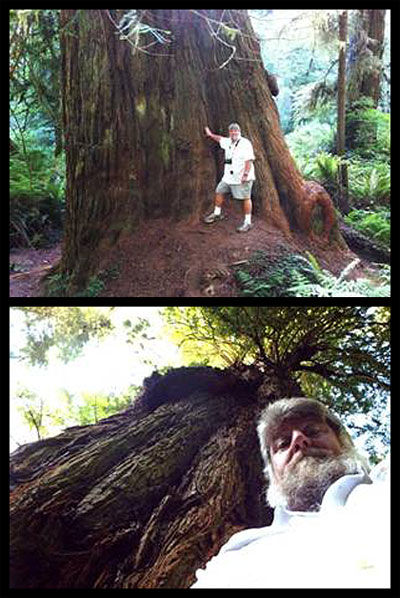
Steven communes with the giants at Redwood National Park.
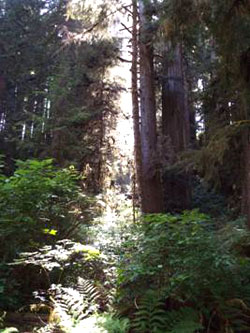
A shaft of sunlight illuminates the forest floor below 300-foot-tall trees.
A few hours and several coastline stops later: Redwood National Park. Now, I’ve seen the redwoods before, in Muir Woods north of San Francisco, so I’m pretty stoked about visiting these forests. Turns out the ones in Muir Woods are mere puppies of these big dogs. Holy mother of all things arboreal, these are trees! I whip the truck over and park, because it’s obvious that I am going to wreck this thing if I don’t. I turn the key off and am immediately immersed in an alien world. The air is so quiet, so still, so thick, you can almost chew it. Shafts of sunlight pierce the forest here and there, like gleaming swords in still water. There is simply no sound, yet it is absolutely deafening. How is this possible? A cloak of reverence drops over me, and I bow to its eminence. There is no other word for it: this forest is a cathedral. The sky is visible only in slivers, held aloft above a ceiling of green, pillared by immense columns, each engraved with intricate furrows that extend upward more than 150 feet from the fern-covered floor until they disappear into the undulating dome of foliage above.
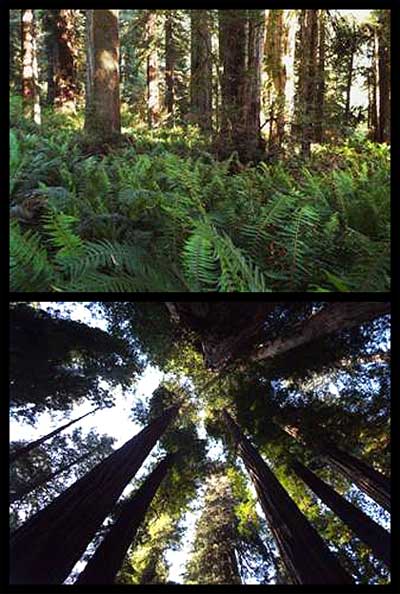
Standing in the same spot, a simple upward tilt of the camera illustrates the complexity of the redwood forest.
I walk like a cat stalking, each step a cautious endeavor. Still … silent … stop. My body is performing some kind of very slight back and forward motion, like a praying mantid. I listen intently … nothing. Not a bird lighting, not a branch dropping, not a leaf crackling. Even the earth beneath my feet is quiet; a soft carpet of tiny leaves atop a thick, spongy cushion … thousands of years in the making. How can I go on? How can I stop? I lean forward and go on, silently, save for the occasional swish of a fern against my shirt sleeve … and my breathing. In this moment, for the first time in my life, I can actually hear the air entering and leaving my body. I am perfectly relaxed and calm, and it seems like I am hearing my breath with my skin, not my ears. I listen intently, only to be interrupted by the sound of a car passing on the road, some 200 feet away. As soon as it passes, the forest quickly eats the sound and absolute quiet returns.
I soon encounter a tree that completely mesmerizes me. I whisper to her, quietly laugh with her. Her bark is soft beneath my hand. I gaze around at her sisters, her community, and realize that everything in this forest is soft, plushy. I think this is the secret to this alien silence, then immediately realize that the silence is the native state of being here, and I am the alien. I acquiesce to her majesty, and thank her for the lesson. Two full hours now in this forest, and I have heard not one flit of a bird, not one movement but my own, yet my ears are full of sounds now. I cannot discern what they are, but I can hear them.
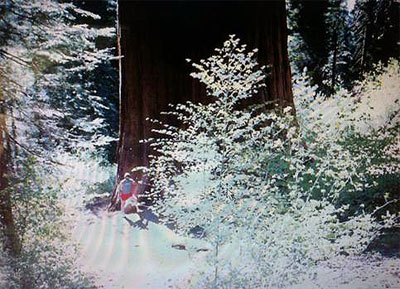
A vintage 1990 photo of Steven visiting the giant sequoias in Yosemite National Park.
The power of the experience seems to dwarf the amazing science surrounding the redwoods. Somewhere in this vicinity, a 379-foot tree was discovered in 2006, and subsequently named Hyperion, in honor of “The High One” from Greek mythology. As of this date, this is the tallest tree on the planet, and its exact location is kept guarded. (The official reason is to prevent disturbance of the surrounding ecosystem, but more likely it is to protect the tree from some lunatic who would take pleasure in harming or killing it.) The lowest limb is more than 200 feet from the ground, making the climb to the top to measure it a harrowing, yet exhilarating experience. (Check out www.npr.org/the-world’s-tallest-tree.) And for all that height, Hyperion is a relatively young tree, estimated at 700 to 800 years old. By comparison, some ancient redwoods are more than 2,000 years old … and many show their age in broken limbs and split trunks that have re-sprouted and formed new crowns.
Coastal redwoods (Sequoia sempervirens) naturally range in a narrow band along the Pacific coast, from the extreme tip of southern Oregon to about 150 miles south of San Francisco. They are taller and more slender (diameters to 22 feet) than the giant sequoias (Sequoiadendron giganteum), which have diameters up to 40 feet, grow to about 250 feet tall, and can live for more than 3,000 years in their natural range of the Sierra Nevada Mountains, some 200 miles to the east. Both species are truly natural wonders.
The rest of the 2,547-mile trip is a blur of desert, rock formations, wildflowers, and windmills. Seven days after starting out, I pull up to my in-laws’ new apartment and open the truck door. Sounds fill the air — mockingbirds, cardinals, sparrows, and somewhere off in the distance, a semi down-shifting. Home. To be sure, it was an adventure: rivers immense, coastlines intense, redwoods incredible, and memories indelible. But there’s something wonderful about sleeping in your own bed, and realizing that there are plenty of adventures to be lived right here at home.
Steven adds these notes:
Come out and breathe in the beauty of a Texas summer at Chandor Gardens! Go to www.chandorgardens.com for details. Just take I-20 west to exit 409, hang a right, go 2.1 miles and hang a left on Lee Avenue. Head straight 12 blocks and you’re driving in the gates. Call 817-361-1700 for more information.
I can always use another road trip! Let me know if you’d like me to come out and speak to your group sometime. I’m low-maintenance, flexible, and you know I like to go just about anywhere. No city too big; no town too small. Just send me an e-mail at stevenchamblee@yahoo.com and we’ll work something out.

